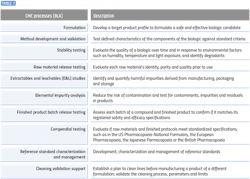The journey begins when a new biologic entity shows promise in the lab. From there, a pharmaceutical company must seek permission to continue its investigation of the drug’s therapeutic potential in humans. At this critical stage, the company must navigate a complex regulatory landscape which includes filing an Investigational New Drug Application (IND) and subsequent Biologic License Application (BLA).
Each application will include a chemistry, manufacturing and controls (CMC) section to ensure drug products are consistently effective, safe and high quality for consumers when they are manufactured. To maximize the chances of gaining regulatory approval, companies must provide CMC plans and meticulously collected data that align with U.S. Food and Drug Administration (FDA) expectations.
Developing a CMC strategy
A CMC strategy is an approach to providing the FDA with scientific data characterizing the therapeutic molecule, its stability and formulation, the manufacturing process, and how the manufacturer is planning to ensure consistency and control of the product throughout the product life cycle. The tricky part about a CMC strategy is the fact that it may not be a straight path to market, especially if the biologic is granted FDA fast-track designation. These strategies would consist of pursuing multiple paths to get to market as soon as possible, while still ensuring a controlled product. The CMC strategies to produce a chemical or biologic should be established early on and used throughout the drug development process to provide continuity between clinical trial results and commercial use.
The manufacturer communicates the CMC strategy to the FDA by providing a robust CMC package that outlines a biomanufacturer’s process for testing, scaling and optimizing a biologic; it must be efficient, reliable and consistent, and it must meet regulatory expectations to lay the groundwork for commercial production. It should describe core characteristics about the biologic including its ingredients and their purpose, its molecular, chemical and physical characteristics — particularly stability — as well as evidence that the biologic produces the intended biological effect.
A CMC strategy must provide evidence of a detailed manufacturing plan to produce the biologic, as well as anticipated administration methods. Additionally, the CMC strategy must provide a robust and reliable testing protocol for conducting quality control and safety assessments, such as forced degradation and stability testing. Finally, the strategy must describe the facilities where the biologic and all other relevant components will be manufactured, including how they are designed, maintained and operated as well as their qualifications to ensure high-quality production.
A complex process, accelerated
The development process for biologics is often granted fast track designation after IND application approval, meaning that later processes, such as the compilation of data for the BLA application, may proceed on shorter timelines (Table 1). The FDA grants fast track designation to drugs and biologics that meet an unmet need to treat a serious condition. The designation expedites the development process by rendering the pharmaceutical company eligible for priority review and accelerated approval of documents. It also entitles the company to more communication with the FDA to discuss the biologic’s development, ensuring all necessary data are being collected to support approval, and to further discuss clinical trial design.
When a biologic has been granted fast track designation, its accompanying regulatory applications are eligible to be assessed under the rolling review policy, by which a company may submit portions of its BLA to the FDA as they are produced, rather than having to assemble a complete application to submit.
The fast track designation is a great boon to the development of a new biologic because it enables manufacturers to bring products that address substantial, unmet medical needs to market as fast as possible. At the same time, there is not much leeway when it comes to developing a robust CMC strategy that ensures the safety and efficacy of a biologic on such a tight schedule. Therefore, manufacturers should initiate the development of a CMC strategy as early in development as possible, in addition to meeting their other expedited timelines, to get a head start on conducting CMC for their novel biologic.
Because assembling a complete CMC package is an incredibly time- and labor-intensive process, an additional strategy that pharmaceutical companies use to hit the ground running is to pre-design broad CMC strategies that are applicable to multiple product pipelines. These pre-designed strategies function as a starting point, but because every drug is different, each must be tailored to the mode of delivery (e.g., inhalant, injectable, controlled release, solid dose, topical, oral) and the platform technology of any new drug. Biologics, having been designed for personalized medicine approaches or to target a rare disease, tend to be more functionally and molecularly diverse than other kinds of drugs on the spectrum. So, while the system of starting with a pre-designed template does speed the process up, CMC strategies for biologics still require significant revision.
Building a case
While meticulously collecting data to go into a CMC package, a manufacturer must carefully consider how each piece of information meets FDA expectations and builds a cohesive case for the biologic it is developing. The CMC strategy must provide scientific evidence and irrefutable rationale to support the design of the workflow that outlines how each step will eliminate risk during manufacturing and will maximize the production of a high-quality product. Then, during development, manufacturers should reflect on instances when production of the biologic is being put to practice to identify risks in the process and predict potential pitfalls — and this should also be detailed in the CMC strategy.
In short, to produce an exemplary CMC strategy, no stone may go unturned. Therefore, manufacturers should take every opportunity to work with the FDA to ensure that they are building a body of data that provides the necessary level of detail to illustrate that a biologic molecule and its indication are scientifically understood and that its formulation and manufacturing are optimized. Companies should not underestimate the complexity of the process and should strive to be thorough, particularly when identifying potential sources of risk. By doing so, they can then optimize product development by systematically removing sources of risk from underlying processes, and only decide to take risks that can be justified by sound scientific reasoning. Otherwise, taking shortcuts may lead to expensive and nonproductive studies or leave critical gaps in the CMC strategy.
Manufacturers should anticipate feedback from the FDA and build additional time into their development schedules to respond and provide revisions. In some cases, revisions requested will be extensive; however, the company must do all additional work that is required to satisfy the FDA’s expectations. Failing to do so risks reducing the quality of the biologic and therefore its eligibility to reach the market. If at any point the FDA finds that a company is not meeting its expectations surrounding CMC, it may fine the company, pause production or even withdraw the market authorization of the biologic.
Consistency is key
To ensure that the final CMC strategy is optimized, manufacturers should begin thinking about CMC during target development, and continue to hone the strategy during preclinical formulation and clinical research. Pragmatic companies will consider several CMC strategies in parallel and evaluate these based on several parameters: A CMC strategy should maximize the safety and efficacy of a biologic while at the same time ensuring availability to patients and satisfying regulatory requirements; it should be practical to carry out based on the manufacturer’s needs. By performing continuous improvement of the plan, and adapting the strategy should new information emerge during development, companies will streamline the process of establishing the optimal strategy for their biologic and can circumvent unexpected roadblocks that would otherwise derail development and commercial release onto the market.
Streamlining CMC with a CDMO
While large pharma companies have abundant in-house resources and experience to plan, optimize and implement a CMC strategy, smaller biopharma companies with fewer resources may face challenges in this arena. For instance, larger companies have the infrastructure set up to test their biomolecules, refine their manufacturing protocols and validate their methods. Smaller biopharma companies do not have these capabilities on hand.
Increasingly, smaller companies are carrying out a larger proportion of early drug development activities. Because they do not have sufficient resources or experience to craft a CMC strategy, they will often partner with a CDMO to advise them. As a manufacturer takes a biologic candidate into the Current Good Manufacturing Practice (cGMP) and CMC phases of development, a CDMO’s advice can be instrumental in streamlining the process.
A CDMO partner will make its resources and experience available to a biopharma company as it is preparing to submit its new biologic for review. The regulatory, quality and technical expertise that CDMOs can offer, as well as the consulting services, can be key to the preparation of an optimal CMC strategy. Furthermore, a CDMO can offer a wealth of scientific knowledge to justify all elements of the CMC plan. Because an experienced CDMO knows the many different approaches that manufacturers take to CMC design and how the FDA responds to those strategies, they are well-equipped to guide manufacturers through the application process.
Enlisting the help of a CDMO can also be a good option for small companies that would like help managing the cost of CMC development. Cost can become prohibitive if companies try to undergo CMC without cost controls. On the other hand, a CDMO can work within a CMC budget and anticipate how the various steps and decisions will affect it throughout product development.
In sum, CMC is a segment of all INDs and BLAs that is critical if a biologic is to reach the market. Developing a satisfactory CMC strategy is a massive, expensive undertaking. Large companies might feel that they have the resources and expertise to manage the CMC design independently, but small companies may appreciate drawing on the experience and resources of a CDMO, particularly if they are developing their first product.
Either way, companies need to develop a comprehensive, reliable CMC strategy to achieve regulatory and commercial success and finally bring a new treatment to patients with few other options.


